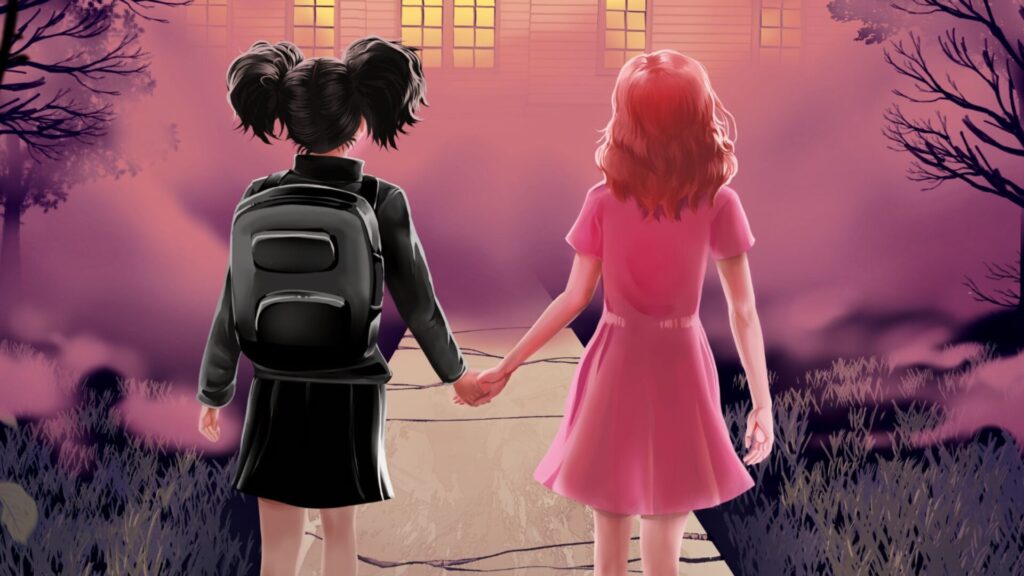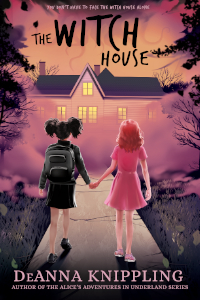When I started writing The Witch House, I had no idea what I was going to write. I didn’t even have a title. I was stuck on the big project I was working on and wanted a break.
When you sit down and write and don’t think too hard about what you’re going to write—if you don’t do a lot of conscious planning—then something else takes over. This other thing is a small voice that won’t try to shout over your conscious mind’s other plans, but as long as you’re not sure what to write anyway, why not listen?
I did. I really enjoyed it.
Looking back now, I can see that a lot of influences went into The Witch House, including some things I haven’t thought of for years and years. It’s almost like that voice in my head was waiting for an excuse to play with some of its favorite toys.
A lot of things inspire me. I just don’t always know about them until after I’m already inspired.
YOU DON’T HAVE TO FACE THE WITCH HOUSE ALONE
Jayla Jackson is a witch. Or is she?
She dresses in black, has zero friends, is super-smart, and doesn’t fit in.
But that doesn’t make her a witch…
…right?
When Jayla’s English teacher makes her class start writing in journals for class—but says they don’t have to tell the truth in them—Jayla boldly declares that she’s a witch.
She starts making up spells, talking about her familiar (a ghost cat), and writing stories about all the terrible things she’s done. She didn’t mean to hurt anyone, she says, but that doesn’t make her feel any better.
Her English teacher just smiles and praises her for being creative.
But Jayla has real secrets hiding underneath her made-up confessions.
There is a witch in town.
And Jayla must face her if she wants to save her family and her new friend, Lola, too.
Coraline
(the 2002 novel by Neil Gaiman and 2009 movie)
I read the book when it first came out and found it delightfully creepy. Even before the Other Mother was revealed as evil, I knew there was something off about her—and the world that Coraline is transported into.
I feel like it very much caught the way it feels to fall into (and escape) the clutches of someone who tries to distort your perception reality in order to get what they want.
And of course the movie version is a pure delight.
Madoka Magica
(the original 2011 anime series)
My daughter got me to watch Madoka Magica with her. She’d already seen it and insisted that I not watch any trailers or look up the show before I watched it—good choice. I won’t spoil anything here, so I’ll just say that the witches of Madoka Magica had a very strong influences on the witches in The Witch House.
The series itself taught me a lot about writing big plot twists: how to craft them, how to hide them, and how to make them pull on the heart as well as surprise.
If you’re at all interested in how girls are socialized in middle school, give Madoka Magica a look.
And if you know Madoka Magica, of course check out The Witch House!
Fruits Basket
(the 1998-2006 manga series and 2019 anime series)
I started reading Fruits Basket after they started coming out in English volumes; it was one of the first manga series I read and was the first series I collected—and is one of my favorite creative works ever. The large, conflicted extended family at the heart of Fruits Basket reminded me of my own somewhat isolated, inward-facing family, with many similar patterns (even if my relatives don’t turn into animals when hugged).
I return to this series when I’m exhausted, heart-sore, and frustrated.
Fruits Basket tells hard truths without giving in to despair.
I’m currently watching my way through the new series and enjoying it very much.
Labyrinth
(the 1986 movie)
If Coraline was a movie that helped teach the current generation’s kids that they could choose to empower themselves and validate their own judgment, then Labyrinth was a movie that helped teach kids of my generation the same thing.
It didn’t always work—a lot of us grew up idolizing David Bowie’s character Jareth more than we should have—but I’ve heard a lot of people my age say that they come back to the movie again as adults, particularly after getting out of bad life situations, and say that they find that the movie still touches them.
We still need to know these things: “You have no power over me” and “Remember, fair maiden, should you need us…”
Yes. We absolutely still the the power that comes from facing the complexities of growing up.
ParaNorman
(the 2012 movie)
When I saw this movie, I thought it was cute and had good characters but I didn’t think about it much further than that. I didn’t really realize that it had worked its way into my subconscious idea of witches until I wrote this story. I think the ending affected me more than I knew, particularly in finding out about Aggie and how her pain, fear, and anger had transformed her.
I handled the ending on The Witch House differently, but that’s okay. I can still go back and watch ParaNorman if I need it.
The Dark Crystal
The Dark Crystal. I don’t rewatch it as often as I have Labyrinth, but it holds a deep place in me, particularly the conflict between the Skeksis and the Mystics and how they are different parts of the same people, split off from each other so they don’t have to acknowledge their own full selves.
The older I get, and the more I have to learn how to accept parts of me in order to function as a whole human being, the more that part of the movie hits home.
The movie confused me when I first watched it. So many things are never explained directly to the audience. But I think I respect the movie all the more for it. In the real world, we often don’t get the resolution we want, or any resolution at all.
That doesn’t mean our stories aren’t meaningful or worthwhile.
The Neverending Story
(the 1979 novel and 1984 film)
I don’t know about you, but the edition of The Neverending Story that I first read had green and red ink in it! The fantasy world was in green, and the “real” world was in red, and there were huge capital letters with illustrated backgrounds, in red and green. It was one of the first books that I read at the town library after my country school closed and I switched schools. I was only a little older than Bastian Balthazar Bux when I first read it.
I’ve always liked that The Neverending Story was fiction about fiction (also known as metafiction). The Witch House isn’t fully metafiction, but it touches on it a few times.
And of course Falkor is an inspiration for one of the characters in The Witch House. Shh.
The Body Snatchers/Invasion of the Body Snatchers
(the 1955 novel and 1956 film)
This is one of the movies mentioned in The Witch House by name.
I read the original book for The Body Snatchers as part of a reading challenge for the best horror stories of all time. I have a love/hate relationship with stories about people being replaced by copies of themselves. That is, I love the stories because I find them so creepy. Since I was a kid, I’ve been asking myself, “If I were replaced by a copy of myself, would I know?”
Probably not…if it were a good copy.
The Stepford Wives
(the 1972 novel—I haven’t seen the films)
The Stepford Wives is a horror story about women who are programmed into losing their personalities by the men who “love” them. It isn’t just one or two wives who are programmed, but an entire town full of them. Their husbands lured them to the town on purpose.
The Witch House isn’t about the same thing. But it’s pretty close.



